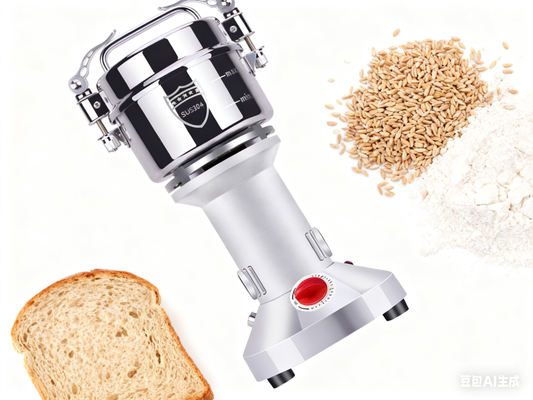
Ultimate Guide to Grain Grinder for your kitchen.
Ultimate Guide to Grain Grinders for Your Kitchen
Introduction
In today's culinary world, the push for freshness and quality has led many home cooks and bakers to consider investing in a grain grinder. These handy devices allow you to transform whole grains into flour, unlocking a world of flavors and nutritional benefits. In this guide, we’ll explore the real-life benefits of grain grinders, what to look for in a quality model, and the ideal use cases where these devices truly shine.
Real-Life Benefits of Grain Grinders
-
Enhanced Freshness and Flavor
- Grinding your own grains ensures that your flour is fresh, preserving the natural oils and nutrients that can degrade over time in pre-packaged flour. This freshness translates into improved flavor in your baked goods, making a noticeable difference in taste.
-
Nutritional Superiority
- Whole grains are rich in vitamins, minerals, and fiber. By milling your own flour, you retain these nutrients, promoting healthier eating habits. This is especially beneficial for families looking to incorporate more wholesome ingredients into their diets.
-
Cost Savings
- Buying whole grains in bulk is often more economical than purchasing pre-ground flour. A grain grinder can pay for itself over time, particularly for avid bakers who frequently use flour in their recipes.
-
Customization of Flour
- With a grain grinder, you have the flexibility to choose the type of grain you want to use. Whether it’s wheat, oats, corn, or alternative grains like quinoa and rice, you can create customized flour blends tailored to your dietary preferences and recipe requirements.
-
Sustainability
- Milling your own grains reduces packaging waste associated with store-bought flour, contributing to a more sustainable kitchen. This eco-friendly approach aligns with the growing trend toward responsible cooking and eating.
Comparison of Upright and Swing Grain Grinders
Choosing the right grain grinder can enhance your kitchen experience. Here are five models to highlight, helping you find the one that best suits your needs.
1. Upright 150g Grain Grinder
- Capacity: 150 grams, ideal for small batch use.
- Features: Compact design, easy to store, perfect for everyday home use.
- Advantages: Lightweight and suitable for occasional grinding; great for beginners.
2. Upright 550g Grain Grinder
- Capacity: 550 grams, suitable for medium household needs.
- Features: Efficient and quick, ideal for flour needed for baking bread and pastries.
- Advantages: Strong stability, suitable for frequent use, processes various types of grains.
3. Swing 750g Grain Grinder
- Capacity: 750 grams, perfect for family gatherings or small baking needs.
- Features: Swing design helps ensure even grinding.
- Advantages: Easy to operate, suitable for grinding multiple grains, enhances efficiency.
4. Swing 1000g Grain Grinder
- Capacity: 1000 grams, ideal for larger batch grinding needs.
- Features: Powerful motor capable of quickly processing various grains.
- Advantages: Suitable for frequent baking or making large quantities of food, saves time.
5. Swing 2000g Grain Grinder
- Capacity: 2000 grams, perfect for commercial use or large-scale baking.
- Features: High efficiency, capable of quickly grinding large amounts of grains.
- Advantages: Durable, ideal for professional kitchens and bulk production.
What to Look for in a Quality Grain Grinder
-
Type of Grinder
- Manual vs. Electric: Manual grinders are typically more portable and affordable, making them great for occasional use. Electric grinders are faster and more efficient, ideal for regular bakers or those who need larger quantities of flour.
-
Grinding Capacity
- Consider how much flour you typically need. If you bake frequently or for a large family, opt for a model with a higher capacity to save time and effort.
-
Adjustable Grind Settings
- Look for a grinder that offers adjustable settings to achieve different textures, from fine flour for pastries to coarser textures for breads and cereals.
-
Ease of Cleaning
- Choose a model with removable parts that are easy to clean. This will help maintain the grinder’s performance and longevity.
-
Durability and Build Quality
- Invest in a grinder made from high-quality materials. A robust construction ensures that your grinder will withstand regular use and provide consistent results over time.
Ideal Use Cases: Where These Devices Truly Shine
-
Baking Fresh Bread
- For bread enthusiasts, grinding your own flour adds depth and flavor to your loaves. Using freshly milled whole wheat flour can enhance the nutritional profile and taste of your bread.
-
Making Homemade Pasta
- Freshly ground flour is perfect for pasta-making. Using high-quality grain allows you to create a more flavorful and textured pasta that elevates your dishes.
-
Cereal and Porridge Preparation
- Grinding grains like oats, barley, or quinoa can yield fresh flour for porridge or breakfast cereals. The ability to grind these grains ensures a hearty and nutritious start to your day.
-
Creating Unique Blends
- Experimenting with different grains can lead to unique flour blends. Mixing various grains allows you to create custom blends for pancakes, cookies, or specialty breads.
-
Gluten-Free Baking
- For those following a gluten-free diet, a grain grinder can be used to mill gluten-free grains like rice, millet, or buckwheat. This offers a fresh alternative to store-bought gluten-free flours, which can lack flavor and nutrition.
Final Thoughts
Investing in a grain grinder can transform your kitchen experience, offering fresh, flavorful, and nutritious flour for all your culinary creations. By understanding the real-life benefits, knowing what to look for in a quality grinder, and exploring ideal use cases, you can make the most of this versatile kitchen tool. Embrace the art of milling your own grains and elevate your cooking and baking to new heights!
No comments







0 comments